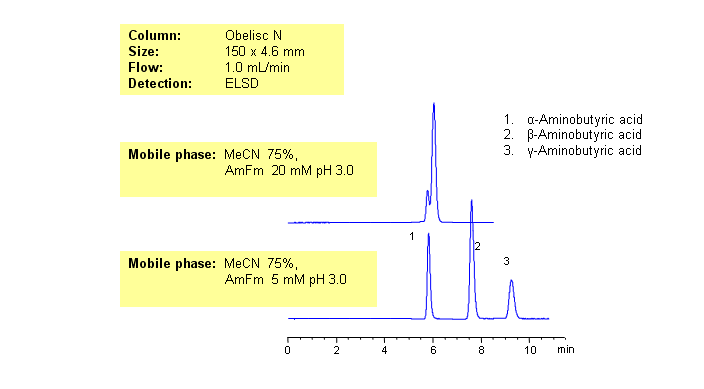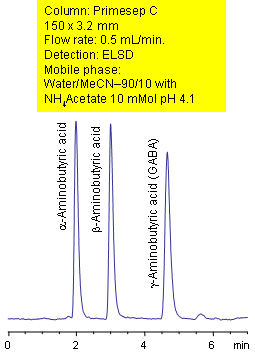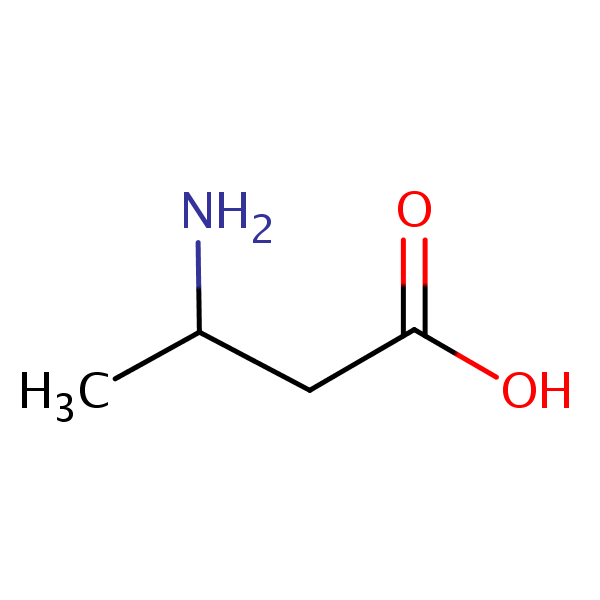| CAS Number | 541-48-0 |
|---|---|
| Molecular Formula | C4H9NO2 |
| Molecular Weight | 103.122 |
| InChI Key | OQEBBZSWEGYTPG-UHFFFAOYSA-N |
| LogP | -1.79 |
| Synonyms |
|
Applications:
HPLC Separation of alpha-Aminobutyric, beta-Aminobutyric, and gamma-Aminobutyric acids on Obelisc N
March 3, 2010

GABA (neurotransmitter) and its isomers are polar zwitter-ionic compounds. Due to the position of amino-groups, all three compounds show different polar and basic properties. The isomers of aminobuturic acid are separated on an Obelisc N HILIC/cation-exchange column. Buffer concentration has a different effect on retention of alpha-, beta-, and gamma-aminobutyric acid. This general and robust method can be used for separation of other polar and ionizable compounds and isomers by mixed-mode chromatography.
| Column | Obelisc N, 4.6×150 mm, 5 µm, 100A |
| Mobile Phase | MeCN/H2O |
| Buffer | AmFm pH 3.0 |
| Flow Rate | 1.0 ml/min |
| Detection | ELSD |
| Class of Compounds |
Acid |
| Analyzing Compounds | Alpha-Aminobutyric acid, Beta-Aminobutryic acid, Gamma-Aminobutyric acid (GABA) |
Application Column
Obelisc N
SIELC has developed the Obelisc™ columns, which are mixed-mode and utilize Liquid Separation Cell technology (LiSC™). These cost-effective columns are the first of their kind to be commercially available and can replace multiple HPLC columns, including reversed-phase (RP), AQ-type reversed-phase, polar-embedded group RP columns, normal-phase, cation-exchange, anion-exchange, ion-exclusion, and HILIC (Hydrophilic Interaction Liquid Chromatography) columns. By controlling just three orthogonal method parameters - buffer concentration, buffer pH, and organic modifier concentration - users can adjust the column properties with pinpoint precision to separate complex mixtures.
Select optionsalpha-Aminobutyric Acid
beta-Aminobutyric Acid
gamma-Aminobutyric Acid (GABA)

HPLC Separation of Isomers of Aminobutyric Acids
May 6, 2004

Primesep C separates the isomers of aminobutyric acids by a combination of reversed-phase and ionic interaction mechanisms. alpha-Aminobutyric acid, beta-Aminobutryic acid, and gamma-Aminobutyric acid (GABA) are baseline resolved without ion-pair reagents. The HPLC separation uses a mobile phase of water, acetonitrile (MeCN, ACN) ammonium acetate with evaporative light scattering detection (ELSD).
| Column | Primesep C, 3.2×150 mm, 5 µm, 100A |
| Mobile Phase | MeCN/H2O |
| Buffer | AmAc pH 4.1 |
| Flow Rate | 0.5 ml/min |
| Detection | ELSD |
| Class of Compounds |
Acid |
| Analyzing Compounds | Alpha-Aminobutyric acid, Beta-Aminobutryic acid, Gamma-Aminobutyric acid (GABA) |
Application Column
Primesep C
The Primesep family of mixed-mode columns offers a wide variety of stationary phases, boasting unprecedented selectivity in the separation of a broad array of chemical compounds across multiple applications. Corresponding Primesep guard columns, available with all stationary phases, do not require holders. SIELC provides a method development service available to all customers. Inquire about our specially-tailored custom LC-phases for specific separations.
Select optionsalpha-Aminobutyric Acid
beta-Aminobutyric Acid
gamma-Aminobutyric Acid (GABA)




